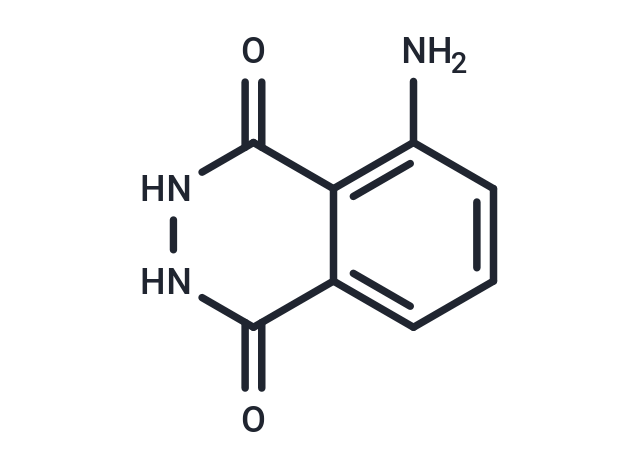Shopping Cart
- Remove All
 Your shopping cart is currently empty
Your shopping cart is currently empty

Luminol (Diogenes reagent)(Diogenes reagent) is a versatile chemical, exhibits chemiluminescence, with a striking blue glow, when mixed with an appropriate oxidizing agent.

| Pack Size | Price | Availability | Quantity |
|---|---|---|---|
| 1 g | $37 | In Stock | |
| 1 mL x 10 mM (in DMSO) | $30 | In Stock |
| Description | Luminol (Diogenes reagent)(Diogenes reagent) is a versatile chemical, exhibits chemiluminescence, with a striking blue glow, when mixed with an appropriate oxidizing agent. |
| In vitro | Instructions for use I. Solution preparation 1. Stock solution: Dissolve Luminol in an alkaline solution (such as 0.1 M NaOH or 50 mM Tris-HCl, pH 8.5–9.0), usually at a concentration of 10–50 mM. Note: The powder should be stored in a dry environment at -20°C away from light; the stock solution can be stored at 4°C for a short period of time, and it is recommended to store it at -20°C after aliquoting away from light for a long period of time to avoid repeated freezing and thawing. 2. Working solution: Dilute the stock solution to a final concentration of 0.1–1 mM. (Please adjust the working solution concentration according to experimental requirements) II. Operation steps 1. Chemiluminescent reaction Luminol generates light through peroxidase (such as H₂O₂) or catalyst (such as iron ions) in the presence of peroxide (such as H₂O₂). 1) Reaction system: 2) Add peroxide (such as 0.1–10 mM H₂O₂) and enzyme (such as 1–10 µg/mL HRP) as excitation agents. 3) Detection method: Measure the light signal by a chemiluminescence detector (such as a microplate luminescence reader). Notes: 1. Luminol is sensitive to light and oxygen. Avoid light and air exposure during operation. 2. Use the working solution as soon as possible after preparation to reduce degradation and signal attenuation. 3. Luminol concentration is an important factor affecting the intensity of chemiluminescence (CL). The intensity of luminol chemiluminescence (LCL) depends not only on the concentration of luminol, but also on other factors such as the concentration of oxidants, enzymes, and pH. The maximum recorded CL intensity is at a luminol concentration of 0.3 mM. In the range of 0.01 to 0.3 mM, the CL intensity increases linearly with the increase of luminol concentration. However, further increasing the luminol concentration resulted in a decrease in the luminescence intensity. |
| Alias | Diogenes reagent |
| Molecular Weight | 177.16 |
| Formula | C8H7N3O2 |
| Cas No. | 521-31-3 |
| Smiles | NC1=C2C(=O)NNC(=O)C2=CC=C1 |
| Relative Density. | 1.433 g/cm3 |
| Storage | keep away from direct sunlight | Powder: -20°C for 3 years | In solvent: -80°C for 1 year | Shipping with blue ice. | |||||||||||||||||||||||||||||||||||
| Solubility Information | DMSO: 45 mg/mL (254.01 mM), Sonication is recommended. | |||||||||||||||||||||||||||||||||||
Solution Preparation Table | ||||||||||||||||||||||||||||||||||||
DMSO
| ||||||||||||||||||||||||||||||||||||

Copyright © 2015-2025 TargetMol Chemicals Inc. All Rights Reserved.